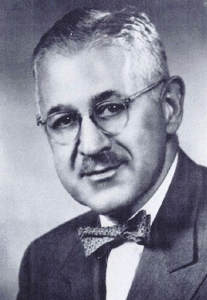
Early in the 1900s, W.G Batemen observed that dogs, cats, rabbits, and humans that were fed a diet high in raw egg whites exhibited toxic symptoms relating to hair loss and skin lesions.
A few years later Margarete Boas and Helen Parsons (1927), performed experiments on rats that showed that if they were fed large amounts of egg white as their only protein source, they exhibited similar symptoms: dermatitis (skin rashes), alopecia (hair loss), and loss of muscular coordination. Boas coined the term ‘egg-white injury’ to describe this syndrome.
Hearing of these earlier experiments, Paul György became interested in egg-white injury. It was in 1933 while working at Case Western Reserve University in Cleveland, Ohio. He worked on this syndrome for many years, until in 1939, he discovered a molecule (another vitamin) in eggs that seemed to be key to this syndrome.
Before getting its final name had also discovered this molecule with each group giving it their own names. These names included several alter-egos such as co-enzyme-R, vitamin H, vitamin B7 and biotin (named from the Greek biotos meaning ‘life’). However, when analyzed it became apparent that vitamin H was exactly the same molecular structure as the family of B-type vitamins (6 of which were known at that time) with biotin becoming its official chemical name.

This substance was isolated from egg yolk by Kogl and Tonnis in 1936 that enabled yeast growth. Subsequent research related to signs of dermatitis and hair loss due to egg white injury were prevented by several researchers by feeding certain foods, notably liver, and kidney. It was recognized in 1936 that this condition can be healed by biotin supplements. Then, Paul Gyorky, Hungarian
biochemist, studied the chemistry of this protective factor in certain foods, which he named factor H in 1937.
Dr. Vincent du Vigneaud in 1942 revealed the molecular structure of biotin. In 1940 Gyorky and associates found that biotin, vitamin H, and coenzyme R were the same substance. This led to the synthesis of vitamins soon after by Harris and co-workers in 1943.[i]
It was first used to boost the strength of horses’ hooves. When researchers saw the difference between the quality of the hooves both before and after, they began studying its many effects on other mammals, including humans.
Moses Wolf Goldberg (June 30, 1905 – February 17, 1964) was an Estonian chemist who, along with Leo Henryk Sternbach, developed a process for the synthesis of biotin (a B vitamin, originally labeled Vitamin H) in 1949 and filed a patent while working at Hoffman LaRoche.
Many cosmetics now include Biotin now that its benefits are well known for strengthening hair, skin and nails. It also works to metabolize carbohydrates, fats, and amino acids, the building blocks of protein.